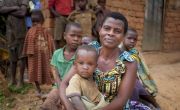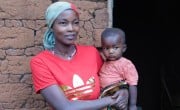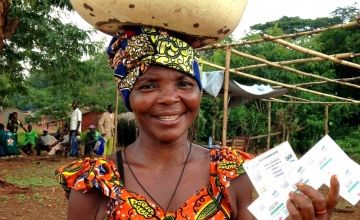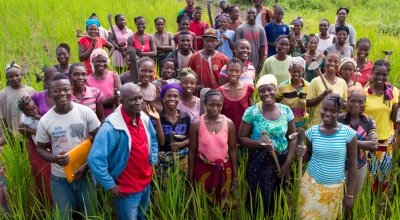
Read our 2023 annual report

Knowledge Hub
We’re in the midst of a global hunger crisis, with the Food and Agriculture Organisation estimating that we began 2022 with 828 million hungry people — more than a 22% increase since the beginning of the Covid-19 pandemic.
Since then, that number has risen steadily due to the ongoing climate crisis and the impacts of both local and international conflict (with the conflict in Ukraine leading to acute hunger levels rising by nearly 25%). Border closures over the last few years have helped to upend the global food system, hurting people living in the world’s hungriest countries the most.
One key response to this, as we discuss in the 2022 Global Hunger Index, is strengthening local food systems to make up for where the global food system has broken down. This dovetails with Concern’s own approach to ending poverty and hunger around the world: By supporting local leadership and ownership over sustainable solutions, the communities we serve can continue to thrive without becoming dependent on an NGO. Here are nine community-based solutions to hunger in action.
1. Community Management of Acute Malnutrition
We can’t talk about community-based solutions to hunger without talking about CMAM (Community Management of Acute Malnutrition). During hunger crises in the 1980s and 1990s, children with severe acute malnutrition required around-the-clock care at therapeutic feeding centres (TFCs). This was problematic for several reasons, including the distance that families often had to travel to reach these centres and the safety risks these centres posed in conflict zones. Many children were taken home before they completed treatment.
Described as a “revolution in the management of severe acute malnutrition,” CMAM (co-developed by Concern) brought treatment home, screening for malnutrition through a group of trained Community Health Workers (more on them below) and providing portable, shelf-stable therapeutic food. Prior to CMAM, child mortality rates during a famine were often between 20 and 30%. With CMAM, that rate has gone as low as 4.5%. Since its original pilot tests over 20 years ago, CMAM has evolved to also predict seasonal “surges” in malnutrition cases, responding proactively rather than reactively.
» Read the full story on RUTF and CMAM.

2. Community Health Workers and Volunteers
For rural areas like the commune of Bukinanyana in northwestern Burundi, treating malnutrition and other effects of hunger can be a challenge. Not every village has a clinic. This is where people like 55-year-old grandmother Jeanette Icimanishatse come in. In Cibitoke, Jeanette is one of a team of Community Health Workers (CHWs) who are trained to detect the early signs of malnutrition and provide medical assistance or referrals as needed.
CHWs are one example of how community members can form local health systems, fighting both hunger and other diseases and illnesses from family homes. They not only receive all of the necessary training to serve their communities, but they also often have higher success and trust rates with their neighbours than outside healthcare providers. That trust helps save lives.
“I think I am a dynamic person, able to conduct the home visits and follow up on the progress made by the household’s members. This is why my community has chosen me. They trust me, as they know I am an honest person,” says Francine Fitina, who was elected as a community Care Group Volunteer from the same province as Jeanette.


3. Mamans Lumières
Behavioural change — especially at the community level — takes time, patience, and trust. Similar to Community Health Workers, Mamans Lumières (or lead mothers) light the way for maternal and newborn health, breastfeeding, and hygiene in their communities, helping mums adapt to the best practices to ensure that they and their children are getting all of the nutrients they need to live long, healthy lives.
“I have learned a lot from her,” says Central African Hermine Kounougoue of her neighbour and Maman Lumière, Nadine Doko. “Much has changed in my life. I think that all my children are healthy because of the advice I’ve received from her.”

4. Farmer field schools
Improving local food systems through agriculture will be key to ending hunger, particularly in rural areas struggling to respond to the climate crisis. That’s where farmer field schools come in handy.
Developed more than 30 years ago as part of a project led by the Food and Agriculture Organisation, farmer field schools have evolved into programmes that reach up to 1 million people across 90 countries each year. The lead farmers are also community members who, trained on practices like Climate Smart Agriculture, then work with their friends and neighbours to spread that knowledge.
“We’re aiming to introduce best practices in farming, which will increase yields while also helping to alleviate malnutrition in the community,” says Forkpa Blamah, a field school lead for Concern in Liberia. “It’s about sharing knowledge and ultimately improving lives.”
It’s about sharing knowledge and ultimately improving lives.
5. Mother Groups
For pregnant and breastfeeding women, finding support in a local group speaks to the old adage that it takes a village to raise a child. Mother Groups (also known as Mother Care Groups) work similarly to farmer field schools, imparting knowledge to groups via local leaders and creating a support system.
“The group is a good support for women in the community,” says Cecelia Morris, the chairwoman of her Mother’s Group in Wrobone Town, Liberia. “Many of them have been encouraged by Concern to set up vegetable gardens and are now able to sell some of what they produce. They earn some money from it, and at the same time, it provides a source of nutritious food for their families. Before, we used to have to buy peppers and bitter bulbs. Now, we can go into our own gardens and pick what we need.”

It also allows support from organisations like Concern to go further: In training 91 Mother Groups in Liberia on best nutrition practices and helping them to develop kitchen gardens, we were able to reach 2,275 families — a positive knock-on effect.
Mother Care Groups are also reliable models for hunger in emergency situations. In Bangladesh, for example, which is currently hosting hundreds of thousands of Rohingya refugees, Concern developed a Mother Group model for caregivers of children under five that has reached over 108,000.
6. Community gardens
Not every family we work with has a farm. But, even in the smallest of spaces, they can grow a garden of diverse, nutrient-rich foods. Working with parents (especially those whose children have been treated for malnutrition), Concern supports the construction of tens of thousands of home gardens (which can include kitchen gardens, keyhole gardens, or sack gardens) that bring fresh vegetables closer to home.
In some cases, these gardens become shared plots of land between neighbours, giving them more space to work with and a larger support system if someone needs help tending their crops. This is especially helpful in refugee and displacement camps, where space and food are both at a premium.
As with many of Concern’s other agriculture projects, these gardens become community-owned and led, with selected members of an area trained on agriculture as well as other nutrition practices.
“This model not only ensures the maintenance of the gardens,” explains Zenon Ndikuriyo, Health and Nutrition Coordinator with Concern Burundi. “But — importantly — it ensures that education is passed through the community and everyone can benefit from the knowledge.”

7. Cooking demonstrations
Something that often goes hand-in-hand with initiatives like Mamans Lumières and Mother Groups are cooking demonstrations, which allow families to learn what to do with the fruits and vegetables that they grow and how to also make the most out of the available resources. These demonstrations are especially valuable as they show not only how to prepare enough food for a meal, but also how to prepare food with enough of the essential nutrients and vitamins (especially to support children’s growing bodies).

8. Seed Fairs
One solution to developing a diverse home garden is to spend a day at the fair. Seed fairs are held in villages to share seeds among local farmers, who are given vouchers that allow them to buy whatever seeds they wish. The quality of the seeds is ensured beforehand through germination and humidity tests for the vendors. Seed fairs encourage exchange for local producers while giving families the autonomy to buy what they wish, and they are also a boost for the local economy. During one seed fair in the Lobaye Prefecture, Central African Republic, 160 farmers participated as vendors, selling seeds to approximately 20,000 people. A total of €90,000 was injected into the prefecture’s economy.
» Learn more about seed fairs.

9. Community-led food banks
With a weakened global food system, people in some areas of the world are finding innovative ways to improve their local food system governance; holding local decision-makers accountable for addressing food insecurity and hunger levels. A recent initiative in Niger, the Shimodu Project, is a good example of tailoring this approach to specific areas.
Community members, local authorities, humanitarian actors, and a consortium of supporting NGOs (including Concern) worked together to identify the needs of several participating localities in the Diffa region. The communities then set up food and fodder banks, where the stock was built up during harvest and other abundant seasons and sold at a community-set price. During lean seasons, the stock was sold back to community members, and the prices they set meant that they weren’t impacted by inflation or price-gouging due to high demand.
Shimodu not only helped roughly 28,000 people across 4,000 families to remain food-secure during the hungry season, it also strengthened local social services, cohesion, and governance.





